状语only doing sth 与 only to do sth的区别教学资料
- 格式:doc
- 大小:17.50 KB
- 文档页数:3
![[转载]only的几种特殊用法词语辨析非谓语的常见误用情况](https://uimg.taocdn.com/17c3a60da66e58fafab069dc5022aaea998f411f.webp)
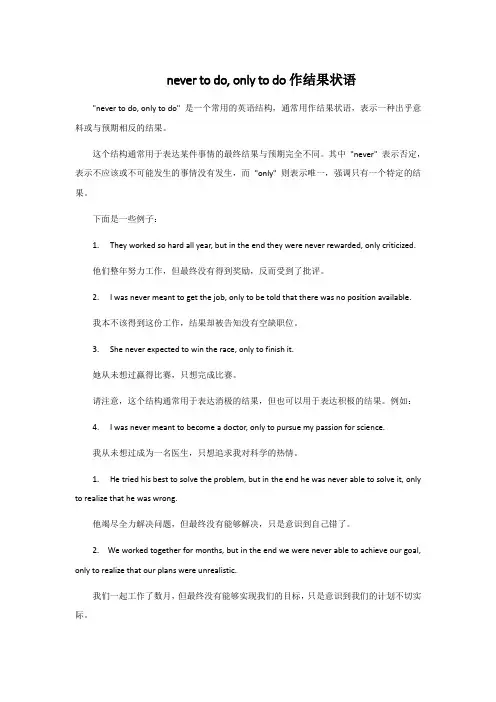
never to do, only to do作结果状语"never to do, only to do" 是一个常用的英语结构,通常用作结果状语,表示一种出乎意料或与预期相反的结果。
这个结构通常用于表达某件事情的最终结果与预期完全不同。
其中"never" 表示否定,表示不应该或不可能发生的事情没有发生,而"only" 则表示唯一,强调只有一个特定的结果。
下面是一些例子:1.They worked so hard all year, but in the end they were never rewarded, only criticized.他们整年努力工作,但最终没有得到奖励,反而受到了批评。
2.I was never meant to get the job, only to be told that there was no position available.我本不该得到这份工作,结果却被告知没有空缺职位。
3.She never expected to win the race, only to finish it.她从未想过赢得比赛,只想完成比赛。
请注意,这个结构通常用于表达消极的结果,但也可以用于表达积极的结果。
例如:4.I was never meant to become a doctor, only to pursue my passion for science.我从未想过成为一名医生,只想追求我对科学的热情。
1.He tried his best to solve the problem, but in the end he was never able to solve it, only to realize that he was wrong.他竭尽全力解决问题,但最终没有能够解决,只是意识到自己错了。
2.We worked together for months, but in the end we were never able to achieve our goal, only to realize that our plans were unrealistic.我们一起工作了数月,但最终没有能够实现我们的目标,只是意识到我们的计划不切实际。
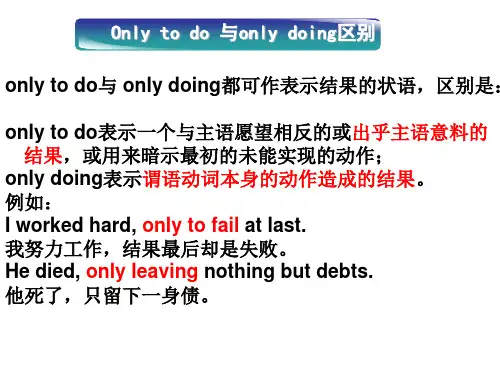

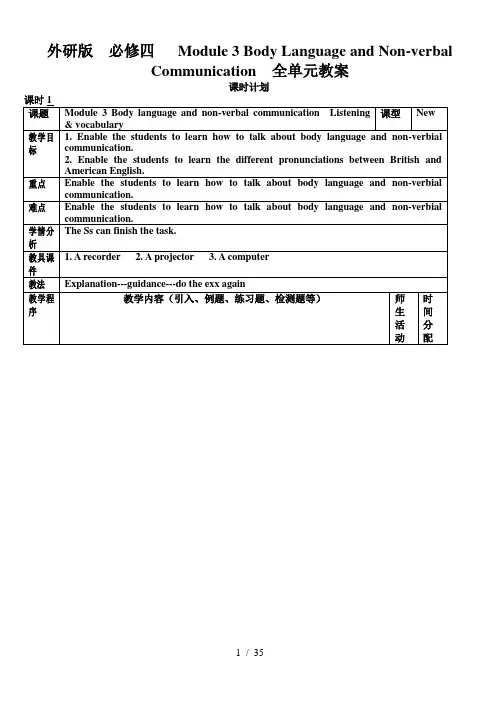
外研版必修四Module 3 Body Language and Non-verbalCommunication 全单元教案课时计划课时1课题Module 3 Body language and non-verbal communication Listening& vocabulary课型New教学目标1. Enable the students to learn how to talk about body language and non-verbial communication.2. Enable the students to learn the different pronunciations between British and American English.重点Enable the students to learn how to talk about body language and non-verbial communication.难点Enable the students to learn how to talk about body language and non-verbial communication.学情分析The Ss can finish the task.教具课件1. A recorder2. A projector3. A computer教法Explanation---guidance---do the exx again教学程序教学内容(引入、例题、练习题、检测题等)师生活动时间分配Step 1 Step Revision1 Proof readingPractice(1) Only in this way ___________ progress in your English. (MET84) (B)A. you makeB. can you makeC. you be able to makeD. will youable to make(2) He is the only one of the students who ___ a winner of scholarship for threeyears. (沪2002春招) (D)A. isB. areC. have beenD. has been(3) Only then ___________ the importance of health. 只有那时我才认识到健康的重要性。

to do 和doing作结果状语的区别一、to do 作结果状语,表示一种出乎意料的,令人失望的结果。
其前常有only,but, enough, never修饰,以加强语气,它们也是选用to do 形式的重要标志。
置于句末,不用逗号隔开。
1.He hurried to the hotel only to be told the tickets had been sold out. 他匆忙到宾馆,结果被告之票已售完。
2.Tom attempted to cover the facts only to let them out.Tom想要掩盖真相,结果却欲盖弥彰。
3.He has money enough to spare.他有足够备用的钱。
4.In 2004 he left home never to return.2004年他离开家后就从来都未归。
二、doing 作结果状语; 置于句末,但其前常用逗号隔开。
表示一种自然而然的,合乎逻辑的结果。
A little plane crashed into a hill, killing all 5 people in it.一架小型飞机撞入山中,造成机上5人死亡。
Football is played in more than 80 countries,making it a popular sport. 超过80个国家的人都在踢足球,随之足球变成一项受欢迎的运动。
His parents died, leaving him an orphan.他的双亲去世了,留下他一个孤儿。
练习题:A.findingB. to findC. be foundD. finds2.A.breakB. to breakC. BreakingD. broken3.A.to tellB. tellingC. tellsD. be told4.A.leavingB. to leaveC. to be leftD. leaves5.out.A.to tellingB. be toldC. tellingD. to tell。
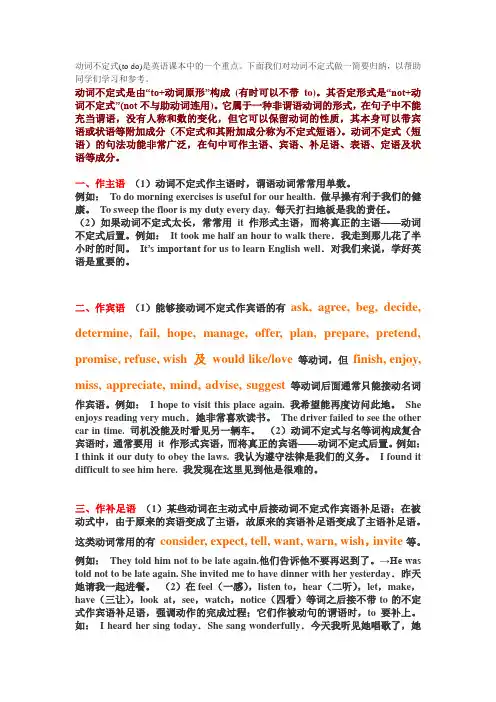
动词不定式(to do)是英语课本中的一个重点。
下面我们对动词不定式做一简要归纳,以帮助同学们学习和参考。
动词不定式是由“to+动词原形”构成(有时可以不带to)。
其否定形式是“not+动词不定式”(not不与助动词连用)。
它属于一种非谓语动词的形式,在句子中不能充当谓语,没有人称和数的变化,但它可以保留动词的性质,其本身可以带宾语或状语等附加成分(不定式和其附加成分称为不定式短语)。
动词不定式(短语)的句法功能非常广泛,在句中可作主语、宾语、补足语、表语、定语及状语等成分。
一、作主语(1)动词不定式作主语时,谓语动词常常用单数。
例如:To do morning exercises is useful for our health. 做早操有利于我们的健康。
To sweep the floor is my duty every day. 每天打扫地板是我的责任。
(2)如果动词不定式太长,常常用it 作形式主语,而将真正的主语——动词不定式后置。
例如:It took me half an hour to walk there.我走到那儿花了半小时的时间。
It’s important for us to learn English well.对我们来说,学好英语是重要的。
二、作宾语(1)能够接动词不定式作宾语的有ask, agree, beg, decide, determine, fail, hope, manage, offer, plan, prepare, pretend, promise, refuse, wish 及would like/love等动词,但finish, enjoy, miss, appreciate, mind, advise, suggest等动词后面通常只能接动名词作宾语。
例如:I hope to visit this place again. 我希望能再度访问此地。
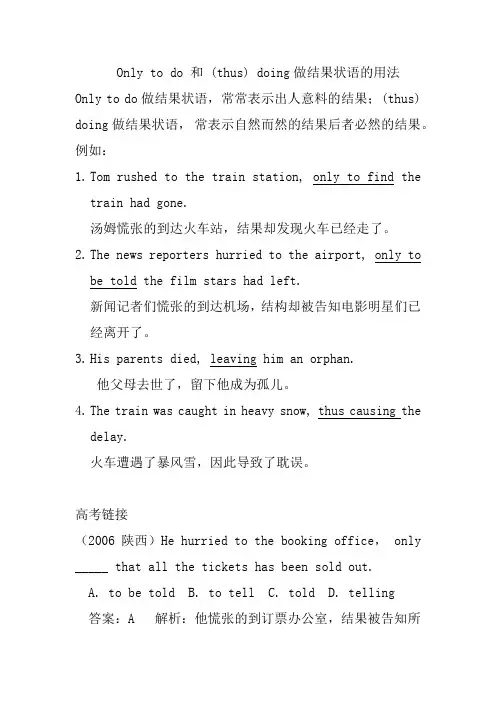
Only to do 和 (thus) doing做结果状语的用法Only to do做结果状语,常常表示出人意料的结果;(thus) doing做结果状语,常表示自然而然的结果后者必然的结果。
例如:1.Tom rushed to the train station, only to find thetrain had gone.汤姆慌张的到达火车站,结果却发现火车已经走了。
2.The news reporters hurried to the airport, only tobe told the film stars had left.新闻记者们慌张的到达机场,结构却被告知电影明星们已经离开了。
3.His parents died, leaving him an orphan.他父母去世了,留下他成为孤儿。
4.The train was caught in heavy snow, thus causing thedelay.火车遭遇了暴风雪,因此导致了耽误。
高考链接(2006陕西)He hurried to the booking office, only _____ that all the tickets has been sold out.A. to be toldB. to tellC. toldD. telling答案:A 解析:他慌张的到订票办公室,结果被告知所有的票已经卖完了。
only后接不定式表示出人意料的结果。
(2009上海)A small plane crashed into a hillside fivemiles east of the city, _____all four people on board.A. killedB. killingC. killsD. to kill答案:B 解析:一架小型飞机在这城市以东5公里处坠毁于山坡里, 机上四人全部死亡。
用现在分词做结果状语。


only 的用法only 是一个在英语中出现频率很高的词,它的意思繁多,用法复杂,不少学生常误用。
一、only 用作形容词1. 与the 连用,意为“惟一的”,作定语。
如:John is the only boy in his family.约翰是家里惟一的男孩。
She is the only girl here who knows how to drive a car.她是这儿惟一会开车的姑娘。
Jeremy is the only friend who lives near, all my other friends live far away.杰里米是我惟一住得近的朋友,其余的朋友都住得很远。
2. only 可修饰复数名词,意为“仅有的、惟一的一些”,作定语。
如:They were the only people present.出席的只有他们这些人。
3. 与an 连用,意为“单独的”,作定语。
如:Jim was an only son of his parents.吉姆是他父母的独子。
4. 与the 连用,意为“最好的、最适当的”,作定语。
如:She is the only person for the job.她是做这项工作的最佳人选。
He is the only man for me.对于我来说,他是最合适的人The only thing to do on a hot day is to go swimming.在热天最理想的事就是去游泳。
二、only 用作副词1. 常位于所修饰的动词、短语或从句前,意为“只是、仅仅”。
如:At present we can only wait and see.目前我们只好等一等看。
I only touched it.我只不过摸了它一下。
I only regret that I have but one life to lose for my country. 我惟一遗憾的是:我仅有一次生命可以贡献给我的祖国。

only to do sth造句Only to do sth是英语中的一个表达方式,它表示某个结果或情况出现了,但这个结果或情况是通过一些不易或不符合预期的方式实现的。
它强调在达成某件事情之前,必须经历一些艰辛的过程或付出一些代价。
本文将介绍Only to do sth的基本用法、语法结构和例句,帮助读者更好地理解和运用这一表达方式。
一、基本用法Only to do sth通常用于句首或句中,表示某个结果或情况出现了,但是这个结果或情况经过了一些艰辛的过程或付出了一些代价。
它可以强调某件事情所需要的难度,或者强调过去失败的尝试。
例如:Only after working hard for several months did he finally pass the exam.(只有经过几个月的努力工作,他才终于通过了考试。
)He traveled to Canada four times, only to be rejected every time.(他四次前往加拿大,每次都被拒绝。
)Only when we work hard can we achieve our goals.(只有我们努力工作,才能实现我们的目标。
)二、语法结构Only to do sth的基本语法结构是only + 状语(表示结果或情况)+ did/have done(助动词)+ 主语 + 表语(动词的过去分词),其中主语和表语可以互换。
例如:Only by working hard did he achieve his dream.(只有努力工作,他才实现了他的梦想。
)Only after failing several times, did herealize the importance of hard work.(只有经历了几次失败,他才意识到努力工作的重要性。
)Only to be left alone, she finally understood the true meaning of love.(只有被孤独地留下,她才终于明白了爱的真正含义。
高考英语非谓语精品练习选择题部分1.She ran as fast as she could _____ to catch the early bus.A.to hopeB. hopeC. hopingD. hoped【解析】此题的答案是C,其中的现在分词短语hoping to catch the early bus 用作伴随状语。
句意:她快速的跑,目的是为了赶上早班车。
2.Before going overseas he devoted all he could _______ his oral English.A. improveB. to improveC. improvingD. to improving【解析】此题答案选D,注意两点:一是devote ... to ... 是固定搭配,意为"把......贡献给......";二是其中的to 是介词,不是不定式符号,后接动词时要用动名词。
3.The target of new technologies is to make life easier, ______ it more difficult.A. not makeB. not to makeC. not makingD. do not make【解析】答案应选B,容易误选C,受题干中的逗号的影响,认为是现在分词表结果的用法。
其实句中的逗号相当于连词and 或but,not to make it more difficult 是对逗号前的不定式to make life easier 的补充说明。
此句的意思是"新技术的目的是为了使生活变得更好”。
4.Once your business becomes international, _____ constantly will be part of your life.A.you flyB. your flightC. flightD. flying【解析】最佳答案为D。
非谓语动词之to do和ing的区别一,作主语时的区别不定式指较具体的行为Ing表示抽象或者泛指的动作(但在实际应用中通常已经可以互换)注意:两者都可以用it作形式主语,但结构不同1)ing词it is + no using/no good/useless/ a waste of time + doing sthThere is no + ing =it is impossible to do sth Eg.it’s no use waiting here.There is no telling why he did so.(there is no knowing/there is no persuading=it is impossible to persuade …)2)to do 不定式It is +adj(n)+(for sb)/(of sb) + to do sthEg. It is very difficult to drive in the mountains.It is a shame to say like that .二,作表语时的区别不定式强调一次具体动作Ing强调抽象行为三,作宾语不定式agree decline 拒绝refuse offer promise choose decide determine attempt intend manage fail ask hope want tend expect desire wish seek plan prepare pretend learn mean dare arrange demand happen intendIng 词admit stand appreciate avoid finish complete consider delay deny suggest enjoy escape forgive keep mind miss practise riskadvise allow permit forbid 或者介词短语的宾语go on insist on , persist in , keep on , take to 喜欢,dream of , get down to , 等等四,作定语不定式后置与修饰词之间有动宾关系必要时要添加介词He is a pleasant fellow to work with .常表示未来发生的动作The man to come our assitance is Mike.在the first, the second , the best, the only thing 等后常加不定式作定语He is always the first to answer questions.Ing词1)多为合成词表中心词的性质Parking lot , sleeping bag, drinking water, cooking oil,。
副词详解副词else 用法小议1.表示“别的”“其他的”,主要用法如下:(1)用于much, little, all (=everything)等之后。
如:Not much else is known. 其他的不太很清楚。
There’s little else we can do now.现在我们几乎没什么别的事可做了。
If all else fails, you may be advised to have an operat ion. 如果其他手段都不见效的话,可能建议你动手术。
(2)用于以-one, -body, -thing, -where 结尾的词之后。
如:Nobody else said anything. 再没有人说什么。
Mangan has nothing else. 曼根没有别的东西了。
She sings better than anyone else in her class.她在班里唱得最好。
In that case someone else will come.如是这样,会有别人来的。
This ring cannot be bought anywhere else.这只戒指是在其他地方所买不到的。
We went to the cinema and nowhere else.我们去电影院了,没到别的什么地方去。
(3)用于who, what, where等疑问词之后。
如:Who else was at the party? 晚会上还有谁?What else have you bought? 你还买了些什么?Where else did you go? 你还到什么地方去了?注意,else 通常不放在which 之后。
顺例说一句,else 可与where构成一个新的副词elsewhere,意为“在别处”“到别处”。
如:She may have been sent to work elsewhere.她可能被派到别处工作去了。
不定式的用法教师版一、不定式的时态和语态很抱歉让你等了那么长时间。
I'm sorry to have kept you waiting so long.很高兴和你一起共事。
I am very glad to be working with you.被给予机会在会上发言我感到荣幸。
I think it's an honor to have been given a chance to speak at the meeting.二、不定式的句法功能1.不定式作主语(1)不定式作主语可以用于句首像那样做是愚蠢的。
To act like that is foolish.(2) 不定式作主语也可以用it 作形式主语,把真正的主语不定式短语置于句末。
并常用于以下句式中:①It+be+名词+to do照顾老人是我们的职责。
It's our duty to take good care of the old.②It takes sb+some time+to do你花了多久完成这个工作?How long did it take you to finish the work?③It+be+形容词+for sb+to do你抽这么多烟对身体很不好。
It is not good for you to smoke so much.注:在句型③中,常用表示客观情况的形容词,如:easy, difficult, hard, important, possible, impossible, comfortable, necessary, better;the first, the next, the last, the best, too much, too little, not enough④It+be+形容词+of sb+to do把老师说的一切都记下来是不明智的。
It is stupid of you to write down everything the teacher says.注:在句型④中,常用careless,clever,good,foolish,honest,kind,lazy,nice,right,silly,stupid,wise rude, clever, foolish, thoughtful, thoughtless , brave, considerate, selfish等表示赞扬或批评的词。
状语o n l y d o i n g s t h与o n l y t o d o s t h的区别
状语only doing sth 与 only to do sth的区别
比较“only+现在分词(短语)”和“only+不定式(短语)”:这两个结构在句中都可以用来表示结果。
但有区别:后接现在分词往往表示一种自然的合乎逻辑的结果,而后接不定式往往表示一种出乎意料的或令人失望的结果。
如:
He went out of the room with few clothes on, only feeling rather cold. 他出去时衣穿得很少,渐渐地感到有些冷了。
I arrived at the shop only to find I’d left all my money at home. 我到商店却发现钱全放在家里。
He lifted a rock only to drop it on his own feet. 他搬起石头砸了自己的脚。
I arrived at the shop only to find I'd left all my money at home. 我到商店却发现钱全落在家了。
His opposition served only to strengthen our resolve. 他一反对反而增强了我们的决心。
She ran to the station only to find that the train had left. 她跑到火车站,但火车却开走了。
Yesterday I went to see him ,_____that he had gone abroad two days before.
A.only to learn B) only learning
答:
昨天我去看他,才知道他两天前已经出国了。
不定式作状语,表示结果。
“ only +不定式”结构常用来作句子的结果状语,表示随后发生的动作是一个未曾预料到的令人懊丧的结果,或表事先没有预料到的,要放在句子后面。
例如:
1. They lifted a rock only to drop it on their own feet. 他们搬起石头却砸了自己的脚。
2. I hurried to the airport only to be told that the plan had taken off. 我匆匆忙忙赶到机场,却被告知飞机早已起飞了。
二 . 表示结果的“ only +不定式”结构,可以改为由 and 或 but 连接的并列句,但仍然表示结果之意。
例如:
I ran to the school, only to be informed that I wasn”t admitted by Beijing University.
相当于:I ran to the school and was informed that I wasn”t admitted by Beijing University. 我是跑着去学校的,却被告知没有被北京大学录取。
三. “ only +不定式”结构也可以表示目的。
例如:
She didn”t call you only not to trouble you. 她没给你打电话是不想给你添麻烦。
四. “ if only to do... ”表示语气上的转折,常译为:“即使只是为了……”。
例如:
I would rather make a journey to Emei Mountain, if only to enjoy some fresh air. 我宁愿去峨眉山,就算只是为了呼吸一点新鲜空气也值。
五. “ have only to do sth. ”结构意为“只要……就行”。
例如:
You have only to finish your own job. 你只要完成你的那份工作就行了。
六. “ have only to... to... ”结构表示“只要……就”。
例如:
You have only to call us in 8 hours to get a set of software worth of 60 dollars. 只要在 8 小时之内给我们打电话,你就会获得一套价值 60 美元的软件。